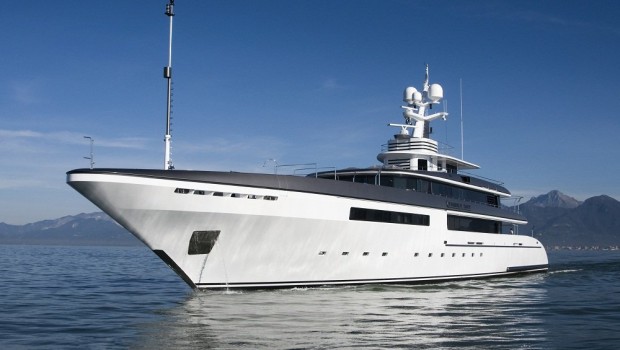Insiders’ Guide to Superyacht Sailing
Published on October 14th, 2013
We’ve all seen them, those otherworldly yachts of such size and expense. So what is it like onboard these personal pleasure palaces? Julie Perry spent three years as a superyacht stewardess, traveling to 40 ports and 18 countries where she served the world’s billionaires onboard their massive ships. As the author of The Insiders’ Guide to Becoming a Yacht Stewardess, Julie provides The Daily Traveler with a bit of insight about the high life at sea…
How did you get into this business?
Carl, my friend from high school, graduated and got a job as a deckhand—he eventually became the youngest yacht captain in North America by the time he was 22. When I graduated from Indiana University, I went for a year abroad with BUNAC, and the travel bug bit. Carl called me up one day, and said “hey, we have a position on board.” I took a month to get rid of all my stuff and put it into my parents’ basement—by the time I got down there [to Ft. Lauderdale] he had given the job to someone else. But within another month, I landed a job as a second stewardess on a 150-foot boat.
What are the responsibilities?
You’re managing a five-star resort. If guests come onboard and there aren’t working pens, you’re responsible for that. You have to type up the instructions to use the phone or the remote. You’ve gotta make sure there are lightbulbs in the light fixtures. When you’re in Croatia and a guest asks if you have any hot rollers on board…well, if you don’t have something, there’s nothing like a guest’s wrath. Especially when they’re paying $70,000 to be on that boat.
You talk about private yachts and charter yachts in your book. What’s the difference between the two?
On a private yacht, the owner might only have time to use it three or four times a year, so when the owner’s not on board, the crew is just working 9 to 5. They still live on the boat, they just do maintenance—there’s always work to do on the boat. The crew gets to enjoy the destination more. And if you’re in St. Barth’s, you’re not really bitter about staying put.
On charter ships [when owners rent out their yachts], you could have a guest for 20 days. Sometimes you only have two or three days between trips to get ready for the next charter. You have the most demanding people in the world, and you’ve got this rule that you can’t say no—no problems, there are only solutions. You sometimes are really working around the clock to keep up with the laundry, to keep up with guests who wake up in the middle of the night and want a sandwich and there’s only one chef on board.
So it sounds like private yachts are the plush gigs?
Well, if you’re chartering a Russian mafia guy, you know that if you work your tail off, at the end of that period the guest will hopefully tip you between 5 and 15 percent—you could walk away with several thousand dollars in cash. Even if you’re working 15 days straight in Turkey, Croatia, and Greece, you don’t really think “I need breaks.”
But, do you ever get any breaks?
It all just depends. Sometimes between clients, you’ll have cash in your pocket, and the captain will say, “Ok, we’re going to Mykonos, and we’re going to anchor out for a week. You can sit in the Jacuzzi, and you can go party and play with the water toys.” That’s why there’s a lot of turnover even boat-to-boat. Crew will hop boats a lot—so you’ll work for three months just living in three months in the shipyard, then do another charter season, then you’ll be exhausted and go on a yacht that only the owner uses.
With that much ship-hopping, do most of the world’s yacht crew know each other?
People like to think of it as a secret world, but crew know where crew are. There are tons of industry forums, Facebook pages, and publications. And there are two main areas of the world: in the U.S. it’s Ft. Lauderdale, and in Europe it’s Antibes. In those areas, there’s a high concentration of training schools. And everybody gets familiar with a certain set of bars.
There must be juicy crew gossip, then?
You’ve gotta be careful in this industry. Even though it spans the globe, it’s a very small world. You hook up with some guy in St. Martin, and you’re both crew members…that information has already hit Antibes within 12 hours. Be careful if you’re trying to keep that away from a girlfriend on another ship. That information travels fast. But if you’re going to have any semblance of a normal life, you are hooking up with your crew mates. Otherwise, you’re out there combing the port. So, a lot of onboard hookups lead to marriages.
Do you eat the same food as the guests?
The crew is not eating what the guests would eat necessarily, but I always say one of the biggest benefits of yachting is the food. You have this world-class chef on board, who also has to cook for the crew. In a lot of cases, guests will order so much food—it’s picky, specialty stuff. And then they come on board and they never eat it all. So when they leave, they usually pay the bill, and the crew are left with it. After a big charter trip, the chef will prepare some celebratory feast for the whole crew.
In my book, I mentioned this story about an owner whose yacht was built in Italy. He thought it would be fun to stock the ship with Italian wine. After the first year with the vessel, he did his maiden voyage and took it from Italy to the Caribbean—then he decided, “I’m not really digging this Italian wine, get rid of it.” It wasn’t even, “I like the pinots, keep those,” it was, “no Italian wines, I want all French.” We each took a couple of bottles for ourselves, put those in our cabins and saved it for a rainy day. Then we just had to give it out to the shipyard workers. They’re skipping home with $3,000 bottles of merlot.









 We’ll keep your information safe.
We’ll keep your information safe.